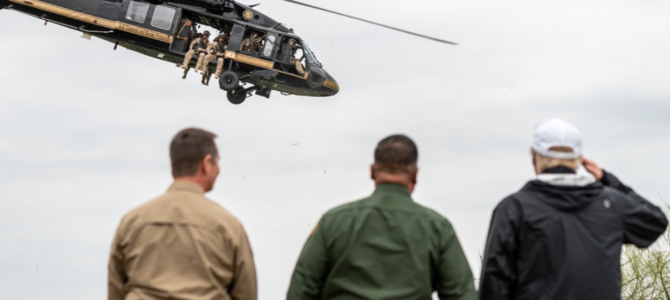
It’s time for an overhaul of the U.S. national security establishment. No subjects of failed policy are more evident than Afghanistan and our southern border.
Afghanistan cost us $45 billion last year with little to show for it. Meanwhile, our southern border is awash with desperate human beings trying to make a better life in our great country. All the while narcotics are flowing across to feed our insatiable habit.
An incident just this week illustrated the violence escalating across the border in Mexico — this time against Americans, when a drug cartel ambushed the LeBaron family in broad daylight, killing at least three women and six children. All the while, the Mexican government fails to act.
Abraham Lincoln said as a young man:
From whence shall we expect the approach of danger? Shall some trans-Atlantic military giant step the earth and crush us at a blow? Never. All the armies of Europe and Asia … could not by force take a drink from the Ohio River or make a track on the Blue Ridge in the trial of a thousand years. No, if destruction be our lot we must ourselves be its author and finisher. As a nation of free men we will live forever or die by suicide.
His words are still true today. No other country in the world comes close to U.S. defense spending. The last fiscal year budget was $686 billion, which dwarfs every near peer threat. Money alone does not ensure victory, of course. Most importantly, no country possesses the strategic lift capabilities needed to truly threaten our existence as a nation through invasion. Some have nuclear capabilities, some have cyber influence capabilities — which can be more dangerous than physical military might — but none can threaten our homeland with conventional forces.
A few colleagues and I war-gamed a U.S. invasion and came to the conclusion that you’d need the largest navy in the history of the world and more than 40 divisions just to start. After that, you would face the most well-armed population on Earth in an insurgency — not a pleasant prospect. China, Russia, North Korea, and Iran do not have the conventional military force capability to destroy us. They remain nuclear threats, but our own abilities in that realm are a counterbalance.
What about international terrorist groups? Terror attacks are especially frightening, as they are designed to be, but is there a group that could pull off an attack so devastating it ends our country? Unlikely, but we will come back to this.
What Threats Does the U.S. Face?
What, then, is a threat to the United States? Abroad, adversaries threaten the free flow of trade by limiting freedom of navigation. There are threats to the control of vital mineral resources. Propaganda assaults our way of life.
We cannot overlook these threats, but a greater threat comes from within. No, not progressive safe spaces! It’s the destructive habits of drug users. Tens of thousands of Americans are dying every year, and U.S. pharmaceutical companies and drug trafficking through ports of entry with Mexico are perpetuating these deaths.
In Mexico, almost 100 people are murdered each day, cartel leaders bribe presidents, and Central Americans are trafficked on an unprecedented scale. In several places, violence is worse than in the Middle East. The recent battle in Culiacán shows the determination of cartel elements to impose their will upon civilians and the government.
Mexico cannot be classified as a failed state by current definitions, but the government has ceased to exist as a functional governing entity in almost 80 percent of the country. Our leaders have consistently decided to ignore these issues and look across the oceans at faraway lands.
Afghanistan cannot be seen as anything but a failure. Yet we remain there while we also spend billions around the world in other strategically irrelevant areas. Seventeen soldiers have died this year in Afghanistan. Few Americans know their names. Who will be the last to die, and what story is going to be told to their families that justifies their loss?
Meanwhile, Mexico is one of the most dangerous places on earth, and Central America has an incredibly low standard of living. No wonder people are streaming to our great country! A humanitarian crisis has been occurring for years, and administration after administration has ignored it. What good is our powerful military stationed all over the world if on our very border is a failing state?
The U.S. Needs a Logical Approach to Border Security
One side of the political machine wants zero border controls and to allow anyone and everyone to come into our country. This is illogical. It has been proved time and again that terrorists and radical Islamists have cooperated and coordinated with cartels. They exchange tunneling knowledge, communications techniques, and weapons, and they traffic in human beings. Drugs and precursor materials flow both ways, and terrorists may use existing smuggling networks to infiltrate the United States.
The other side of the political machine wants a secured border and possibly reductions in legal immigrants, which is not enough to keep up with either economic or population needs, the demand for which also incentivizes illegal migration. This is also illogical. We need these legal immigrants. They consistently work hard, doing jobs many Americans don’t want to do. They have tight familial groups and tend to reproduce at higher rates than Americans.
Regardless, people will circumvent the wall and bribe officials at ports of entry. If you believe cartels don’t already have a footprint on U.S. soil to achieve this, you are wrong. If you believe no U.S. officials are corrupt, you are also wrong.
A wall and decreased legal immigration will not solve our problems. Having zero border controls will not solve our problems, either. A measured logical approach based on common sense is the only solution, and I have a proposition.
A Plan to Address U.S. Border Issues
1. Increase U.S. military presence on the border.
There is a historical precedent for military activity to protect our border and to conduct raids into Mexico when needed. From 1910-1919, the U.S. Army conducted multiple offensive operations to defend Americans in the border regions. Supposedly, members of Delta Force assisted in the raid to recapture Sinaloa cartel leader El Chapo in 2016.
Although we have numerous law enforcement agencies working on the American side of the border, they are undermanned and do not have the technological means to operate in darkness and remote areas. The military has Intelligence, Surveillance, and Reconnaissance (ISR) to conduct this mission. Units need to train regularly on numerous non-combat skills, and the border region offers valuable training for our soldiers. Past National Guard deployments have effectively reduced illegal migrant crossings.
We need a defense in-depth strategy. This means using natural and man-made obstacles to divert human traffic to areas covered by ISR and units that can interdict migrants. Physical barriers can be effective when used at the right geographic location.
2. Start a U.S.-managed work program based in Mexico and Central America.
Qualifying individuals would be biometrically enrolled, transported across the border to farms needing their skills, allowed to work, and allowed to access a path to citizenship. This program would not be easy to administer but has the potential to reduce cartel human trafficking revenue and save thousands from the dangerous journey to the United States.
Immigration is important to the U.S. economy and population. Historically low U.S. birthrates will put a large strain on our entitlement systems, and immigration can help offset that. Without some kind of reformed and streamlined administrative process for citizenship, there is no incentive to assimilate. Biometric technology can be used to track down any outliers.
If this program existed, would we still have illegal immigration and criminality on the border? Of course, but who would undertake such an arduous and dangerous journey if an alternative existed?
3. Fight the U.S. demand for drugs by legalizing marijuana and preventing prescribers from using opiates as a catch-all solution for pain management.
For far too long, opiates were seen as the only answer to treat acute pain. Manufacturers have gotten rich off the prescriptions pumping into the population.
Opiates have now surpassed motor vehicle accidents as a leading cause of death in America. Ending pharmaceutical production of opiates cannot happen fast enough. The Centers for Disease Control and Prevention and the American Medical Association, along with state initiatives, have worked to counter opioid-related deaths, including growing access to Naloxone and issuing more stringent guidelines for opioid prescriptions. These solutions, however, still operate within an opiate-reliant framework.
Marijuana, on the other hand, offers an alternative pain management. States that have legalized medical marijuana show the amount of money that can be made off taxing the product. This money can be used for substance abuse programs.
Cartels also traffic in marijuana, and legalization has the ability to cut into illicit sales. It can also reduce the strain on the justice system and law enforcement, which have enough problems as is.
4. Drastically increase economic development in Central America.
USAID and State Department programs are a sensitive area to discuss, with strong partisan opinions on both sides. The truth is that some programs succeed and some fail. This is not a call for an increased waste of taxpayer funds by the U.S. government.
High levels of poverty, violence, and political instability are strong drivers of immigration from Central America, and over the last few years, U.S. government programs aimed at addressing these drivers saw some significant success. The results were decreased immigration from at-risk areas.
The Trump administration suspended $450 million in aid to Central America this year but reinstated it last month after agreements were made to help curb illegal immigration. Keep in mind, that is just 1 percent of what the United States spent in Afghanistan last year. Taxpayer dollars should be aimed at increasing civilian and foreign investment in these areas to continue driving down these numbers, not spent on LGBT programs.
Congress Must Do Better
Is this plan a silver bullet? Of course not, but so far, no plan our leaders have put forth has been more than partisan arguments. Should we cut back all non-border-related defense spending? Certainly not, but reevaluating our position in world affairs is paramount in guiding our future spending.
Our highly expensive systems could be rendered irrelevant in a future conflict, as other nations simply adapt their tactics. We must still be able to control strategic waterways to ensure free trade and access to all. We must still be able to support our allies by maintaining our power projection abilities.
Just because we are not involved in a major world conflict should not validate our current foreign policy gurus. Failure to think critically about our plans is why we are still in Afghanistan and not in Mexico. The Constitution tasks Congress with providing for the common defense. Congress can do a better job of defending America by rethinking its strategies free of current national security establishment ideals.









